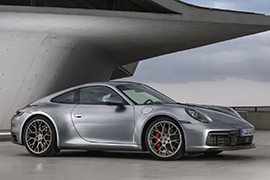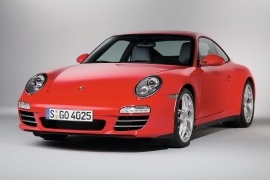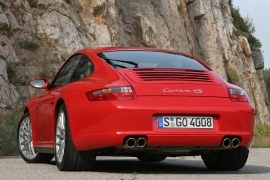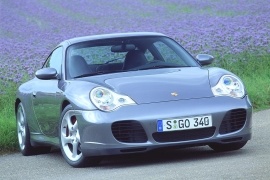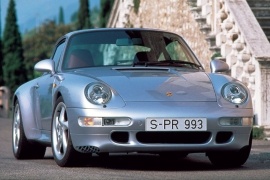PORSCHE 911 Carrera 4S Models/Series Timeline, Specifications & Photos
First production year: 1995
Engines: Gasoline
Body style: Coupé (two-door)
Introduced at the 2018 Los Angeles Motor Show, the Porsche 911 Carrera 4S showed an important evolution compared to the previous generation. It is the eighth generation of the German sports car manufacturer from Stuttgart.
The 911 always had that great spirit of attraction and the eighth generation didn't lose its steam. The eighth generation of the Porsche 911 came with full LED headlights fitted as standard, and an optional, adaptive, Matrix-LED was available on extra-cost. Other safety features were included such as traffic sign recognition or the Lane Change Assist. For the night drive, a Night Vision Assist used an intelligent thermal imaging camera that detects persons and animals and shows them to the driver. It has a range of up to 300 meters (984 ft).
For the infotainment system, Porsche was fitted as standard with a 10.9” touchscreen display. For the sound system, up to three options are available, from Bose or Burmeister. The top version had 855 Watts. The PCM (Porsche Communication Management) can connect to Apple and Android users via Porsche Connect App. It is still not able to connect to Android Auto app.
The most important update is under the hood, where the twin-turbo engine offered 450 hp, which was mated to a standard 8-speed dual-clutch gearbox. The performance gain over the previous generation is important and had a 0-100 kph (0-62 mph) of 3.6 seconds, 0.4 faster than its predecessor.
The 2012 Porsche Carrera 4S was almost as powerful as the last air-cooled 911 turbo, the famous 993 model. But it was faster and easier to live with it as a daily driver.
Driving a supercar every day is something that could be managed in a handful of vehicles. It is not only about the ease of driving but also about reliability. Since JD Power placed 911 on top of the reliability chart among the supercar category, it is understandable why the 911 range increased its sales. But it was not the right car to do the weekly shopping.
There are only a handful of chars with an unmistakably, timeless design on the market. Perhaps the oldest of them all was the Porsche 911. Even after more than half of the century, the original shape was kept. The rounded headlights were kept in the same raised front fenders, even if they are angled. The windshield was not that vertical as it used to be, for aerodynamic reasons, but the unmistakably shaped rear part of the car with the sloped engine compartment is there. And, compared to other Carrera or Carrera 4 versions, the S featured wider rear fenders to make room for wider tires.
Inside, the 2012 911 Carrera 4S featured a small cabin with four seats in a 2+2 arrangement, covered in leather. The center console has been risen to improve the single-seat sports car feeling with the dashboard tilted toward the driver.
The engine was still a flat-six unit and able to deliver 400 hp. It was mated to a 7-speed manual transmission fitted as standard or to the optional 7-speed PDK unit. The all-wheel-drive system allowed good traction in all the weather conditions.
In 2004, Porsche launched a new generation of its well-known Porsche 911. That generation was named 997 and it represented an important upgrade for the whole range, especially after the 2008 facelift.
After four years into production, a mid-life cycle refresh was ready for the market. Porsche had to improve its engines to make them cleaner and to respect the new pollution norms in Europe. It meant that it had to build its cars more fuel-efficient. As usual, the rest of the car suffered some minor changes too.
On the outside, the first difference was on the front bumper, where larger air-intakes were sculptured. The headlights were fitted with bi-xenon lamps while the running lights and taillights were fitted with LEDs as standard. The door mirrors were slightly redesigned. A new set of 19” light-alloy wheels was introduced for the Carrera 4S. As usual, both versions S and 4S featured wider rear fenders. In the rear, the taillights received an LED design. For the 4S, a reflective strip was placed between the taillights.
Inside the car, on the center console, Porsche installed a new infotainment unit that featured a 6.5” touch-screen display. It featured an optional hard-drive navigation system and Bluetooth connectivity. An option for ventilated seats was added to the list.
The biggest change for the 2008 Carrera 4S was underneath the car. The redeveloped 3.8-liter engine featured a direct injection fuel system that increased the power output with 30 hp. A new, PDK 7-speed dual-clutch gearbox was installed on the car, replacing the older 6-speed automatic.
Along with its sibling Carrera 4, the 2005 Carrera 4S offered an all-wheel-drive system for the Porsche 911, but as usual, it was more powerful.
The 997 Carrera 4 S was based on the same platform with its predecessor but enhanced. Its wider body by 88 mm (3.5”) than its two-wheel-drive sibling, made it look meaner. It offered an enhanced all-wheel-drive system, which transferred between 5 and 40% of the torque to the front wheels.
From the outside, the new round headlights were back, wiping off the tears from the Porsche fans. The turn-signals and the fog-lights were in the front bumper, above the apron. In the lower side, a wide center grille and two side-scoops with a horizontal slat were typical for this generation of the Porsche 911. In the back, the Carrera 4S featured four round exhausts under the rear apron, unlike the Carrera 4 which featured only two wide exhausts.
Inside, the Carrera 4S offered four seats but cramped in the rear. It offered four seating options: standard, electric, sport, and adaptive bucket-seats. For the instrument cluster, the Carrera 4 featured the classic five-dials layout, with a black background. The Porsche Communication Management was fitted as standard, but the navigation system was optional.
For the engine, the Carrera 4 S featured a 3.8-liter engine that offered 355 hp, 30 more than the non-S version. It was mated as standard to a 6-speed manual, while a 5-speed automatic with manual override (Tiptronic) was on the options list.
Porsche 911 Carrera 4S received a facelift along with the rest of the range in 2001. It brought a few options and a new pair of headlights. It was fitted with more powerful engines.
The 2002 Carrera 4S came on the market to attract even more customers. It was already established as a true sports-car and a great grand-tourer vehicle. Its rear-engine and all-wheel-drive configuration were highly appreciated especially by those who had to drive on slippery surfaces.
From the outside, the front bumper was identical to the one found in the Porsche Turbo. When compared with the non-facelifted version, the main difference was on the headlights. The 2002 model featured a clear lens for the entire lamp, while its predecessor featured a yellow lens for the turn-signals. The difference was even more striking for the vehicles sold in North America. The wider rear end, carried-over from the Turbo version, and the quad exhaust system looked aggressive.
Inside, the main difference was the stereo, which received a digital AM/FM stereo and a CD-player. Other than that, it was the same four-seat sports car built for two adults for long journeys. In the 911 coupes, the rear seatbacks could have been folded down to create a flat cargo floor. It was a good daily driver vehicle and even more relaxing on long journeys.
The drivetrain received a new 3.6-liter engine and it gained 20 hp more than the non-facelifted version. It was fitted with a standard 6-speed manual. The 5-speed automatic (Tiptronic) gearbox with manual override to change gears was on the options list. Due to its all-wheel-drive system, it could cope better with the bad weather than most of the sports-cars from that era.
After introducing the Porsche Carrera S with the body carried-over from the Turbo version, customers asked about an all-wheel-drive version for it. The Carrera 4S was the answer.
The Porsche 993 was famous for its understeered behavior. And that was noticeable even at lower speeds and on loose surfaces. Due to a new all-wheel-drive system, the Carrera 4S was able to deal better with that and, on a rainy race-track, could do better than its Carrera S sibling.
The Carrera 4S took its bodywork from the Porsche Turbo. But it didn't get the turbocharger. Its wider rear fenders and lowered stance than the Carrera lineup made it a desirable car for the Porsche fans. The windshield was not very raked and the sloped back toward the end of the car made a curved line along with the engine lid. A rear spoiler was installed and it was automatically extended over 80 kph (50 mph), or via a button installed in front of the gear-stick.
The interior featured better sport seats with better support on the shoulders to keep its occupants in their seats while hard cornering. There were two seats in the back, basically only to place some bags, not humans, since they were very small and there were limited legroom and headroom. The instrument cluster featured five dials, with the tachometer in the middle and the Carrera 4S logo on it. The climate controls and the stereo were mounted in line with the steering column.
The engine was the same 3.6-liter naturally aspirated, but it was offered in the higher power output of 285 hp. The only transmission available was a 6-speed manual.
